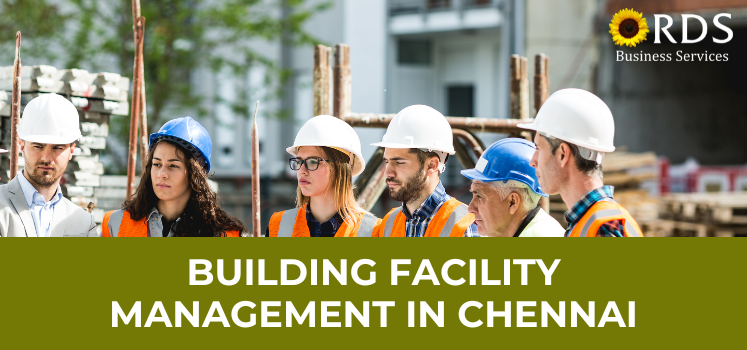
Table of Contents
Chennai, one of India’s fastest-growing metropolises, is at the forefront of urban development. With the city’s expansion comes the need for responsible and sustainable building facility management. As businesses and residential complexes proliferate, the demand for efficient, eco-friendly, and cost-effective facility management solutions is more pressing than ever. This blog delves into sustainable solutions tailored for building facility management in Chennai, emphasizing practices that address the city’s unique climate challenges and infrastructural demands.
The Importance of Sustainable Facility Management in Chennai
Sustainable facility management is the integration of environmentally responsible practices into the management and operation of buildings. In Chennai, where the effects of climate change are increasingly evident, sustainable practices are not just a trend but a necessity. Sustainable facility management can reduce operating costs, minimize environmental impact, and enhance the quality of life for building occupants. Given Chennai’s specific challenges, such as water scarcity, energy demands, and waste management issues, adopting sustainable solutions is crucial for the city’s future.
1. Energy Efficiency: A Critical Priority
Energy efficiency is a cornerstone of sustainable facility management. In Chennai, where high temperatures lead to extensive use of air conditioning and electrical appliances, the need for energy-efficient solutions is paramount. Here are some key strategies:
a. Smart Lighting Systems
Lighting accounts for a significant portion of energy use in commercial buildings. Transitioning to LED lighting, which consumes significantly less energy than traditional incandescent bulbs, is a simple yet effective measure.
- Motion Sensors and Daylight Harvesting: Installing motion sensors ensures that lights are only used when necessary. Daylight harvesting, which involves adjusting the lighting level based on the amount of natural light, further reduces energy consumption.
- Automated Lighting Controls: These systems can adjust lighting levels based on occupancy and time of day, ensuring that energy is used efficiently and reducing waste.
b. HVAC Optimization
Heating, ventilation, and air conditioning (HVAC) systems are often the largest energy consumers in a building. Optimizing these systems can lead to substantial energy savings.
- Regular Maintenance: Ensuring that HVAC systems are regularly serviced and maintained can prevent energy inefficiencies and extend the life of the equipment.
- Smart Thermostats: These devices adjust the temperature based on occupancy, reducing energy usage during non-peak hours. In Chennai’s hot climate, smart thermostats can ensure comfort while minimizing energy waste.
- Variable Refrigerant Flow (VRF) Systems: VRF systems provide individualized control of heating and cooling in different parts of a building, reducing unnecessary energy use.
c. Solar Energy Integration
With Chennai’s abundant sunlight, solar energy is a highly viable option for reducing reliance on non-renewable energy sources.
- Photovoltaic Panels: Installing solar panels can significantly offset a building’s energy consumption from the grid. In Chennai, where sunlight is plentiful, solar energy can power everything from lighting to air conditioning.
- Solar Water Heaters: These systems use solar energy to heat water, reducing the need for electric or gas-powered water heaters and further decreasing energy consumption.
2. Water Conservation: A Vital Necessity
Water scarcity is a persistent issue in Chennai, making water conservation a critical aspect of sustainable facility management. Efficient water use not only conserves this precious resource but also reduces operational costs.
a. Rainwater Harvesting
Rainwater harvesting is an ancient practice that is particularly relevant in Chennai, where monsoon rains can be both a blessing and a challenge.
- Collection Systems: Installing rainwater harvesting systems allows buildings to collect and store rainwater for non-potable uses such as irrigation, flushing toilets, and even cooling systems.
- Urban Flooding Mitigation: Effective rainwater harvesting can also help mitigate urban flooding, a common problem in Chennai during the monsoon season.
b. Greywater Recycling
Greywater recycling involves treating and reusing water from sinks, showers, and washing machines for non-potable uses.
- Reduction in Freshwater Demand: By recycling greywater, buildings can reduce their demand for fresh water by up to 50%, which is particularly important in water-scarce regions like Chennai.
- Customized Solutions: Systems can be tailored to the size and needs of the building, from small residential setups to large commercial facilities.
c. Water-Efficient Fixtures
Upgrading to water-efficient fixtures is a straightforward yet effective way to reduce water consumption in any facility.
- Low-Flow Faucets and Showerheads: These fixtures reduce the flow of water without compromising performance, leading to significant water savings.
- Dual-Flush Toilets: These toilets allow users to select a lower volume of water for liquid waste and a higher volume for solid waste, reducing overall water use.
- Sensor-Based Faucets: These faucets reduce water waste by automatically shutting off when not in use, ensuring water is only used when necessary.
3. Waste Management: A Sustainable Approach
Effective waste management is a cornerstone of sustainability, and in Chennai, where waste disposal infrastructure is still evolving, facility managers have a crucial role to play.
a. Waste Segregation at Source
Segregating waste at its source is the first step in an effective waste management strategy.
- Recyclables: Encouraging occupants to separate recyclable materials like paper, glass, and plastic helps reduce the burden on landfills and promotes recycling.
- Compostables: Organic waste can be separated and composted, either on-site or through community composting initiatives, turning waste into valuable fertilizer for landscaping.
- Non-Recyclables: Properly managing non-recyclable waste ensures it is disposed of in a way that minimizes environmental impact.
b. On-Site Composting
On-site composting is an excellent way to manage organic waste and contribute to sustainable landscaping practices.
- Reduction of Landfill Waste: By composting organic waste, facilities can reduce the amount of waste sent to landfills, where it would otherwise produce methane, a potent greenhouse gas.
- Nutrient-rich soil: The compost produced can be used in landscaping, reducing the need for chemical fertilizers and improving soil health.
c. E-Waste Management
As technology advances, the amount of electronic waste (e-waste) is rapidly increasing. Proper e-waste management is essential to prevent environmental contamination.
- Safe Disposal Protocols: Establishing protocols for the safe disposal and recycling of e-waste ensures that hazardous materials like lead and mercury are handled appropriately.
- Partnerships with Certified Recyclers: Partnering with certified e-waste recyclers helps ensure that electronic waste is processed in an environmentally responsible manner.
4. Sustainable Materials and Resources
The choice of materials and resources used in building construction, maintenance, and operation can have a significant impact on a facility’s sustainability profile.
a. Green Building Materials
Using sustainable building materials reduces the environmental impact of construction and renovation projects.
- Locally Sourced Materials: Using materials that are locally sourced reduces transportation-related emissions and supports the local economy.
- Recycled and Renewable Materials: Materials like reclaimed wood, recycled steel, and bamboo are not only sustainable but also often more durable and cost-effective in the long run.
- Low-VOC Paints and Finishes: Volatile organic compounds (VOCs) found in many paints and finishes can negatively impact indoor air quality. Low-VOC options are healthier for occupants and better for the environment.
b. Eco-Friendly Cleaning Products
The products used to clean and maintain a facility can also contribute to its sustainability.
- Biodegradable Cleaning Agents: Switching to biodegradable cleaning products reduces the amount of harmful chemicals released into the environment.
- Non-Toxic Formulations: Non-toxic cleaning products help maintain indoor air quality, which is especially important in enclosed spaces where chemical fumes can accumulate.
c. Sustainable Landscaping
Landscaping is an often-overlooked aspect of facility management that can have a significant environmental impact.
- Native Plants: Using native plants in landscaping reduces the need for irrigation and chemical fertilizers, as these plants are naturally adapted to Chennai’s climate.
- Xeriscaping: This landscaping method focuses on using drought-resistant plants and minimal water use, making it ideal for water-scarce regions like Chennai.
- Drip Irrigation Systems: Drip irrigation delivers water directly to the roots of plants, reducing water waste and promoting healthy plant growth.
5. Technology Integration for Sustainable Management
Integrating advanced technologies into facility management practices can greatly enhance sustainability efforts.
a. Building Management Systems (BMS)
Building Management Systems are sophisticated tools that help monitor and control various aspects of a building’s operation.
- Energy Monitoring: BMS allows facility managers to monitor energy use in real-time, identify inefficiencies, and make adjustments as needed.
- Resource Allocation: These systems can also manage water use, HVAC systems, and lighting, ensuring that resources are used efficiently across the facility.
- Automation and Control: Automating routine processes, such as adjusting temperatures or turning off lights when not needed, can significantly reduce energy consumption.
b. IoT Devices
The Internet of Things (IoT) brings connectivity and intelligence to facility management, allowing for more efficient operations.
- Smart Sensors: IoT devices, such as smart sensors, can monitor air quality, detect leaks, and manage lighting and temperature. This real-time data allows for quick responses to any issues that arise, reducing waste and improving efficiency.
- Predictive Analytics: IoT devices can collect data that, when analyzed, can predict maintenance needs before issues become critical, reducing downtime and repair costs.
c. Predictive Maintenance
Predictive maintenance uses data and analytics to anticipate when equipment will need servicing, thus avoiding unexpected failures.
- Cost Savings: By preventing equipment breakdowns, predictive maintenance can save money on emergency repairs and reduce operational downtime.
- Increased Lifespan of Equipment: Regular, data-driven maintenance can extend the lifespan of equipment, reducing the need for frequent replacements and lowering overall costs.
Conclusion
In Chennai, where environmental challenges are increasingly complex, sustainable building facility management is not just beneficial—it is essential. By implementing energy-efficient systems, conserving water, managing waste responsibly, choosing sustainable materials, and integrating advanced technologies, facility managers can create buildings that are not only cost-effective and efficient but also environmentally responsible.
RDS Business Services is a leader in providing comprehensive facility management solutions that prioritize sustainability. Our RDS Facility Management Services are designed to meet the unique needs of Chennai’s buildings, offering customized strategies that reduce environmental impact while enhancing operational efficiency. Whether it’s through energy optimization, water conservation, or advanced technology integration, we are committed to helping our clients achieve their sustainability goals.
Take the first step towards a greener future with RDS Business Services. Contact us today to learn how our sustainable facility management solutions can transform your building into an eco-friendly, cost-effective space. Together, we can build a sustainable Chennai.







